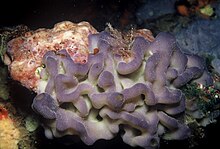| Homosclerophorida | |
|---|---|

| |
| Oscarella lobularis | |
| Scientific classification | |
| Domain: | Eukaryota |
| Kingdom: | Animalia |
| Phylum: | Porifera |
| Class: | Homoscleromorpha Bergquist, 1978 |
| Order: | Homosclerophorida Dendy, 1905 |
| Families | |
| |
Homosclerophorida is an order of marine sponges. It is the only order in the monotypic class Homoscleromorpha. The order is composed of two families: Plakinidae and Oscarellidae.
Taxonomy
Homoscleromorpha is phylogenetically well separated from Demospongiae. Therefore, it has been recognized as the fourth class of sponges.
It has been suggested that Homoscleromorpha are more closely related to eumetazoans than to the other sponge groups, rendering sponges paraphyletic. This view has not been supported by later work using larger datasets and new techniques for phylogenetic inference, which tend to support sponges as monophyletic, with Homoscleromorpha grouping together with Calcarea.
On the basis of molecular and morphological evidence, the two families Plakinidae and Oscarellidae have been reinstated.
There are 117 species in this group divided into 9 genera.
The spiculate genera in this group are Aspiculophora, Corticium, Placinolopha, Plakina, Plakinasterella, Plakortis and Tetralophophora.
The aspiculate species are the genera Oscarella and Pseudocorticium.
Description
These sponges are massive or encrusting in form and have a very simple structure with very little variation in spicule form (all spicules tend to be very small). Reproduction is viviparous and the larva is an oval form known as an amphiblastula. This form is usual in calcareous sponges but is less common in other sponges.
Habitat
Homoscleromorpha are exclusively marine sponges that tend to encrust on other surfaces at shallow depths. These sponges typically inhabit shady locations, under overhangs and inside caves. In the Mediterranean Sea, 82% of the species in this taxon can be found in caves, and 41% of them are found nowhere else.
References
- van Soest, R. (2014). Van Soest RW, Boury-Esnault N, Hooper JN, Rützler K, de Voogd NJ, de Glasby BA, Hajdu E, Pisera AB, Manconi R, Schoenberg C, Janussen D, Tabachnick KR, Klautau M, Picton B, Kelly M, Vacelet J (eds.). "Homosclerophorida". World Porifera database. World Register of Marine Species. Retrieved 2014-05-22.
- van Soest, R. (2014). Van Soest RW, Boury-Esnault N, Hooper JN, Rützler K, de Voogd NJ, de Glasby BA, Hajdu E, Pisera AB, Manconi R, Schoenberg C, Janussen D, Tabachnick KR, Klautau M, Picton B, Kelly M, Vacelet J (eds.). "Plakinidae Schulze, 1880". World Porifera database. World Register of Marine Species. Retrieved 2014-05-22.
- van Soest, R. (2014). Van Soest RW, Boury-Esnault N, Hooper JN, Rützler K, de Voogd NJ, de Glasby BA, Hajdu E, Pisera AB, Manconi R, Schoenberg C, Janussen D, Tabachnick KR, Klautau M, Picton B, Kelly M, Vacelet J (eds.). "Oscarellidae Lendenfeld, 1887". World Porifera database. World Register of Marine Species. Retrieved 2014-05-22.
- Kober, K. M.; Nichols, S. A. (December 2007). "On the phylogenetic relationships of hadromerid and poecilosclerid sponges". Journal of the Marine Biological Association of the UK. 87 (6): 1585–1598. Bibcode:2007JMBUK..87.1585K. doi:10.1017/S0025315407058237. S2CID 84416168.
- ^ Gazave, Eve; Lapébie, Pascal; Renard, Emmanuelle; Vacelet, Jean; Rocher, Caroline; Ereskovsky, Alexander V.; Lavrov, Dennis V.; Borchiellini, Carole (14 December 2010). "Molecular phylogeny restores the supra-generic subdivision of homoscleromorph sponges (porifera, homoscleromorpha)". PLOS ONE. 5 (12): e14290. Bibcode:2010PLoSO...514290G. doi:10.1371/journal.pone.0014290. PMC 3001884. PMID 21179486.
- ^ Gazave, Eve; Lapébie, Pascal; Ereskovsky, Alexander V.; Vacelet, Jean; Renard, Emmanuelle; Cárdenas, Paco; Borchiellini, Carole (May 2012). "No longer Demospongiae: Homoscleromorpha formal nomination as a fourth class of Porifera" (PDF). Hydrobiologia. 687 (1): 3–10. Bibcode:2012HyBio.687....3G. doi:10.1007/s10750-011-0842-x. S2CID 14468684.
- Sperling, Pisani and Peterson 2007, cited in: The Cambrian Explosion p. 80, Erwin and Valentine 2013
- Nosenko, T., Schreiber, F., Adamska, M., Adamski, M., Eitel, M., Hammel, J., Maldonado, M., Müller, W. E. G., Nickel, M., Schierwater, B., Vacelet, J., Wiens, M., & Wörheide, G. (2013). Deep metazoan phylogeny: When different genes tell different stories. Molecular Phylogenetics and Evolution, 67(1), 223–233. https://doi.org/10.1016/j.ympev.2013.01.010
- Laumer, C. E., Fernández, R., Lemer, S., Combosch, D., Kocot, K. M., Riesgo, A., Andrade, S. C. S., Sterrer, W., Sørensen, M. V., & Giribet, G. (2019). Revisiting metazoan phylogeny with genomic sampling of all phyla. Proceedings of the Royal Society B: Biological Sciences, 286(1906), 20190831. https://doi.org/10.1098/rspb.2019.0831
- Ereskovsky, Alexander V.; Ivanisevic, Julijana; Pérez, Thierry (2009). "Overview of the Homoscleromorpha sponges diversity in the Mediterranean". Conference: Proceedings of the 1st Mediterranean Symposium on the Conservation of the Coralligenous and Other Calcareous Bio-concretions.
External links
| Extant Porifera classes | ||
|---|---|---|
 | ||
| Extant animal phyla | |||||||||||||
|---|---|---|---|---|---|---|---|---|---|---|---|---|---|
| |||||||||||||
| |||||||||||||
| |||||||||||||
| Taxon identifiers | |
|---|---|
| Homosclerophorida |
|
| Homoscleromorpha | |
This article about a demosponge is a stub. You can help Misplaced Pages by expanding it. |